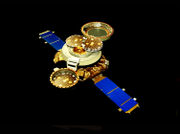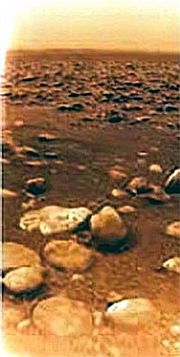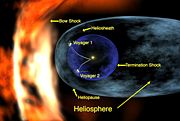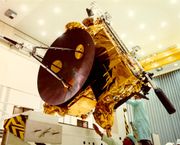 | | __ |
|
| Today is |
|
SPACE
PROBES
|
A space probe is a scientific space exploration mission in hich a robotic spacecraft leaves the gravity well of Earth and approaches the Moon or enters interplanetary or interstellar space; approximately twenty are currently extant. The space agencies of the USSR (now Russia and Ukraine), the United States, the European Union, Japan and China have in the aggregate launched probes to several planets and moons of the solar system as well as to a number of asteroids and comets. TypesA space probe destined is for a planet or other astronomical body can be classified as a " flyby", an "impactor", an "orbiter" or a "lander" mission. Historically, flyby missions proved easiest to accomplish, as they did not require the precise navigation needed for an impact, nor the need for additional propulsion to conduct a maneuver to enter orbit. Upon landing some landers have released "rovers" which travel across the surface of the astronomical body upon which they have landed.  The
Genesis probe
was a sample return mission requiring very little fuel. Once a probe has left the vicinity of Earth, its trajectory will likely take it along an orbit around the Sun similar to the Earth's orbit. To reach another planet, the conceptually simplest means is to execute a Hohmann transfer orbit maneuver. More complex techniques, such as gravitational slingshots, can be more efficient, though they may require the probe to spend more time in transit. A technique using very little propulsion, but possibly requiring a considerable amount of time, is to follow a trajectory on the Interplanetary Transport Network. Some notable probes Luna
1:  The
Huygens landing site on Titan. Huygens
probe: Spirit and Opportunity:  Locations
of Voyager 1 and Voyager 2. Voyager
1: Voyager 1 is the farthest human-made object from Earth, traveling away from both the Earth and the Sun at a relatively faster speed than any other probe. As of August 12, 2006, Voyager 1 is over 14.96 terameters (14.96×1012 meters, or 14.96×109 km, 100 AU, or 9.3 billion miles) from the Sun. At this distance, signals from Voyager 1 take more than thirteen hours to reach its control center at the Jet Propulsion Laboratory. Voyager 1 has achieved solar escape velocity, meaning that its trajectory will not return it to the solar system. Along with Pioneer 10, Pioneer 11, and its sister ship Voyager 2, Voyager 1 is an interstellar probe. See also
|
HISTORY OF ROBOTS -- ROBOTS IN SPACE -- ROBOTIC SURGERY -- ROBOTS IN THE MILITARY -- MORE --
Top Graduate Schools in Education Top Medical Schools in the US (by research and primary care) Top Graduate Schools in Engineering Top Public Colleges and Universities (State Schools)
Carbon Module -- Carbon, graphite, diamond, fullerenes ... 3d structures What were the greatest inventions of all time? List of top 100 all time inventions Explain it with Molecules -- 3d imaging of molecules Basics -- Robotics Robotics in Space Robotics in Medicine Robots in the Home Robots in the Military |
